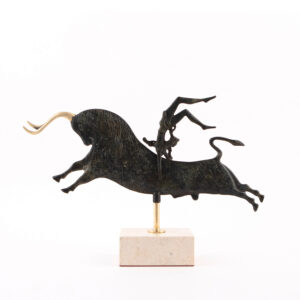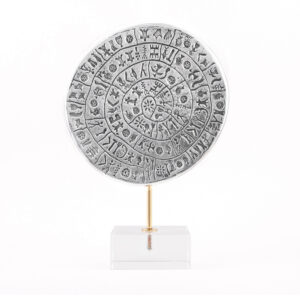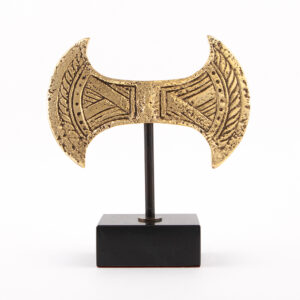
The Minoan civilization, which flourished during the first half of the second millennium BC, is particularly notable for its large and elaborate palaces, in Knossos, Phaistos, Malia, and Zakros. Those imposing structures were built around 1900 BC on agriculturally rich areas that were directly connected to the main sea routes in the Aegean Sea and the east Mediterranean; a creation but also a necessary feature of a centralized economy and social structure. This hierarchy seems to have had the “Priest-King” at its top, based on the archetype of the legendary Minos. It has been speculated that a number of palaces would seem to entail a number of kings instead of one. However, no political rivalries or conflicts between them seem to have existed, so it is probable they were partially independent while under the reign of the King of Knossos, whose hegemony may have been religious in nature.
These great palace complexes had many functions: they were not simply the king’s residence, but the heart of Minoan life and society. Surrounded by populous urban societies, they were also the seat of administrative and judicial power, centers of trade and economy, as well as control stations for the wider area’s financial and productive activity. Goods and products were stored in the palace’s extended storerooms not only for local consumption but mostly for trading purposes. It is possible that most of them were contributed as a form of tax since the Minoans did not have a standardized monetary system. The palace complexes also had a very important religious function, being the main centers of religious life, ceremony, and celebration. Their west wings in particular were devoted to the worship of the Great Mother Goddess, but sacred spiritual elements can be found everywhere.
The architecture and style of those palaces owes certain features to the monumental palaces and temples of the East –which, from a cultural standpoint, Minoan Crete could be considered an offshoot of to a great degree. A common characteristic is a central rectangular court that was both its structural center and the lynchpin of its entire life, but the Minoan palace seems to develop outwards. It is known that these palace complexes were not based on a detailed original design that included the entire finished structure from the beginning, but were, in a way, the natural result of a long-lasting process that consisted of consecutive buildings and many architectural phases.
The palaces were destroyed and rebuilt many times, lasting around 600 years overall. Two main architectural phases can be discerned, the Old Palace period, (the palaces were destroyed, probably by a strong earthquake, around 1700 to 1650 BC), and the New Palace period, were they were built in approximately the same location. Those too, along with most Cretan villages and cities, suffered significant damage around 1450 BC due to a great natural disaster that struck the island. Knossos was eventually destroyed around 1375 BC.
Phaistos, along with Knossos and Kydonia, was according to tradition one of the three main cities founded by King Minos. The hero that gave the city its name, Phaistos, was supposed to be Heracles’ son or grandson. It took part in the Trojan War and later became one of the most important city-states of Doric Crete. Phaistos was an independent city that had its own currency until 180 BC, when it was conquered by its powerful neighbor, Gortyna. Among the city’s deities were Zeus Velchanos –an enduring presence of the young Minoan fertility god– and Leto Phytia.
more moments
Recent Posts
Selected products of the minoan civilization
Share this:
- Click to share on Twitter (Opens in new window)
- Click to share on Facebook (Opens in new window)
- Click to share on LinkedIn (Opens in new window)
- Click to share on Reddit (Opens in new window)
- Click to share on Tumblr (Opens in new window)
- Click to share on Pinterest (Opens in new window)
- Click to share on Pocket (Opens in new window)
- Click to share on Telegram (Opens in new window)
- Click to share on WhatsApp (Opens in new window)




